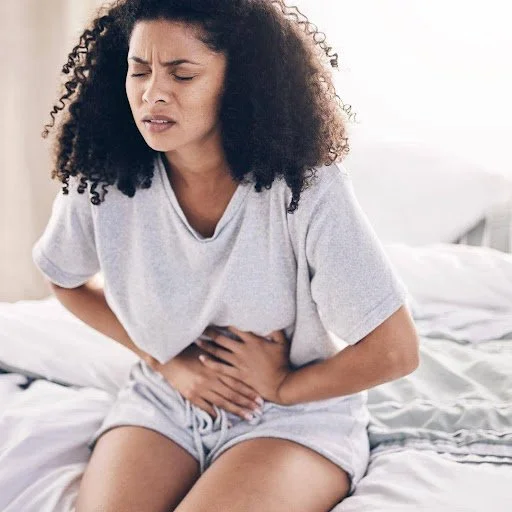Endometriosis: Everything You Need To Know About Symptoms, Causes, Diagnosis & Treatment Options
Do you experience crippling period pain, chronic fatigue, bloating that makes you look six months pregnant ("endo belly"), or pain during sex that leaves you dreading intimacy? Have you been told that your pain is "just part of being a woman"—only to find that no amount of painkillers truly helps?
If this sounds familiar, you’re not alone. Endometriosis affects 1 in 10 women of reproductive age (1), yet it often takes years—sometimes over a decade—to get a diagnosis. The journey can be exhausting, frustrating, and filled with misinformation. But here’s the good news: there are answers, and there are ways to manage your symptoms effectively.
In this blog post, we’ll break down everything you need to know about endometriosis in simple, clear terms. You don’t have to suffer in silence. By understanding endometriosis, you can take back control of your health and start feeling better. Let’s dive in.
What is endometriosis?
Endometriosis is a chronic inflammatory condition where tissue similar to the lining of the womb (uterus) grows outside the uterus, in places where it shouldn’t be—such as the ovaries, fallopian tubes, or even the bowel. This tissue responds to hormonal changes during the menstrual cycle causing inflammation, pain, and scarring.
Endometriosis is often misunderstood and underdiagnosed and it isn’t a one-size-fits-all condition—it can vary in severity and location. Here are the four main types:
Superficial Peritoneal Endometriosis: Characterized by small, flat lesions on the peritoneum, the thin layer lining the abdominal and pelvic cavity, this is the most common and mildest form of endometriosis. It can cause pain and inflammation but is generally less invasive than other forms.
Ovarian Endometriosis: Found on or inside the ovaries, this type can affect ovarian function and reduce fertility by damaging egg reserves. It is more difficult to treat and may require surgery if cysts become large.
Deep Infiltrating Endometriosis: This is the most severe form, where endometriosis grows deep into tissues (more than 5mm below the surface). It can penetrate organs such as the bladder, bowel, rectum, and vagina. It often requires surgery due to its invasive nature.
Extrapelvic Endometriosis: This occurs where endometriosis implants outside the pelvic cavity, such as lungs, diaphragm or C-section scars. It is rare.
Adenomyosis is considered a related condition and often co-exists with endometriosis where endometrial-like tissue grows inside the muscular wall of the uterus.
Symptoms
Symptoms can range from mild to severe, and some people may not even realize they have it until they experience fertility issues.
Common symptoms include:
Pelvic Pain & Severe Cramping – This can occur before, during, or after periods and doesn’t always respond to painkillers.
Heavy or Irregular Periods – May cause anaemia, dizziness, and fatigue due to excessive bleeding.
Pain During or After Sex – Can feel deep, sharp, or aching and may persist for hours.
Digestive Issues ("Endo Belly") – Bloating, constipation, diarrhoea, and IBS-like symptoms.
Chronic Fatigue & Low Energy – Even after a full night’s sleep.
Bladder Issues – Frequent urination or pain when peeing (especially during periods).
Infertility & Difficulty Conceiving – Endometriosis affects up to 50% of women (2) with infertility due to scarring and inflammation.
These symptoms can have a significant impact on daily life for those living with endometriosis including:
Physical Health - Chronic pain and fatigue (due to sleep disruptions or anaemia) make it difficult to carry out daily activities or maintain an active lifestyle.
Mental Health - High rates of anxiety, low self-esteem, depression, and stress due to pain and uncertainty.
Work and Career - Increased absenteeism, difficulty meeting deadlines, and reduced productivity.
Social Life - Social anxiety leads to cancelling plans, avoiding social gatherings, and feeling isolated.
Relationships - Pain during intimacy, reduced sexual satisfaction and emotional struggles can strain personal relationships.
Money - Potentially expensive medical bills for fertility treatments.
Causes & Risk Factors
The actual cause of endometriosis is unknown though there are several theories. It is likely to be due to a combination of different factors.
Retrograde Menstruation (Backflow of Menstrual Blood): During menstruation, some of the endometrial tissue flows backwards through the fallopian tubes into the pelvic cavity instead of leaving the body. These cells implant and grow on surrounding organs, leading to endometriosis.
Genetic Predisposition: Some research suggests endometriosis can be passed down to generations but more research is needed to understand this fully.
Immune System Dysfunction: A weakened immune response may allow endometrial-like tissue to grow outside the uterus instead of being cleared away.
Hormonal Imbalance (Oestrogen Dominance): Oestrogen stimulates the growth of endometrial tissue, and high oestrogen levels may contribute to the progression of endometriosis.
Metaplasia: Metaplasia is the process where one type of cell changes or morphs into a different kind of cell. It usually occurs in response to inflammation (or hormonal or environmental triggers) and enables cells to change to their surrounding circumstances to better adapt to their environment.
Environmental Toxins: Exposure to endocrine-disrupting chemicals (EDCs) like dioxins, PCBs, and BPA found in plastics, pesticides and industrial pollutants may interfere with hormonal balance and immune function, increasing the risk of endometriosis, though research is limited.
Surgical Scarring: After surgeries such as a C-section or hysterectomy, endometrial cells may attach to surgical scars and grow, leading to localized endometriosis.
The Gut-Endometriosis Connection
Did you know your gut health can affect endometriosis symptoms?
The gut is responsible for breaking down oestrogen, but when it’s not functioning properly, excess oestrogen builds up—worsening pain and inflammation. Many women with endometriosis experience digestive issues (bloating, diarrhoea, constipation), sometimes mistaken for IBS.
Furthermore, chronic inflammation can lead to a "leaky gut", where harmful particles enter the bloodstream and trigger more inflammation. The solution to this is a gut-friendly, anti-inflammatory diet (fibre, probiotics, omega-3s) that can help balance hormones and reduce bloating.
How is Endometriosis Diagnosed
The average age at which women receive an endometriosis diagnosis in England is 35 years (3)
Diagnosing endometriosis can be challenging because its symptoms overlap with other conditions such as irritable bowel syndrome, pelvic inflammatory disease, and fibroids. Furthermore in the UK, there is a long delay from the onset of symptoms to an endometriosis diagnosis with the average time being 8 years and 10 months (4). This is due to misdiagnosis, normalisation of period pain, and lack of awareness.
Medical History and Symptom Assessment
A detailed history is usually the first step in the diagnosis of endometriosis as this will help identify whether further testing is needed. The history will typically involve:
Menstrual history – cycle length, heavy bleeding, and severe cramps.
Pain symptoms – pelvic pain, pain during sex, bowel movements, urination.
Digestive issues – bloating, constipation, diarrhoea.
Fertility concerns – difficulty conceiving.
Family history – whether a mother or sister has endometriosis.
Pelvic Examination
The doctor will manually check for tenderness in the pelvic area, unusual lumps or nodules behind the uterus or fixed or enlarged ovaries, which may indicate cysts.
The limitations of this examination are that early-stage endometriosis may not be detectable and not all lesions can be felt manually.
Imaging Tests
These tests help identify signs of endometriosis, but they cannot confirm a diagnosis alone.
Transvaginal Ultrasound (TVUS): Uses high-frequency sound waves to check the uterus, ovaries, and pelvic organs. Although the ultrasound can detect ovarian cysts and large adhesions, they cannot see superficial or small lesions and endometriosis affecting the peritoneum may not appear.
Magnetic Resonance Imaging (MRI): Provides detailed images of the pelvic organs and can detect deep infiltrating endometriosis. MRI’s are expensive and not routinely used unless severe symptoms are present.
Laparoscopy
This is a minimally invasive surgery where a surgeon inserts a thin camera (laparoscope) through a small incision in the abdomen. This allows direct visualization of endometrial-like tissue, adhesions, and cysts and is the gold standard for diagnosing endometriosis. A biopsy (tissue sample) can be taken at the same time for confirmation.
A laparoscopy is usually used when symptoms persist despite treatment or in cases of severe pelvic pain or infertility concerns. Another advantage of this diagnostic procedure is that it can be combined with treatment so if lesions and adhesions are seen, they can be removed.
Treatment Options
Endometriosis treatment aims to reduce pain, slow disease progression, improve fertility and improve quality of life. There is no permanent cure, but various options can help manage symptoms. The right treatment depends on symptom severity, reproductive goals, and individual preferences.
Diet & lifestyle modification
Nutrition plays a vital role in reducing inflammation, balancing hormones and optimising gut health all of which can impact symptoms of endometriosis.
An anti-inflammatory diet can help manage endometriosis symptoms. This diet typically contains foods such as oily fish, leafy greens, berries, citrus fruits, wholegrains, seeds and natural spices with anti-inflammatory properties such as ginger and turmeric; and low amounts of processed foods, refined sugar, alcohol caffeine and pro-inflammatory foods. Foods that support gut health such as fermented foods, foods containing polyphenols and plant foods are also likely to be beneficial. Antioxidant supplements may also help reduce overall inflammation.
Other lifestyle factors such as low-impact exercise, strength training, sleep optimisation and stress management can help reduce inflammation and pain tolerance levels.
Pain Management
Over-the-counter painkillers: Non-steroidal anti-inflammatory drugs (NSAIDs) eg Ibuprofen, Voltarol & Ponstan (Mefenamic acid) can help relieve pelvic pain and menstrual cramps by reducing inflammation. These are best suited if you have mild to moderate symptoms. This is just symptom relief and does not treat the underlying condition. Furthermore, long-term use can cause stomach ulcers.
Heat: a warm bath or a simple hot water bottle may offer some relief.
Pain modifiers: medication that works by altering the body’s perception of pain.
Physiotherapy: Can develop a programme of exercises to help strengthen pelvic floor muscles and reduce pain.
Referral to pain clinic: You can ask your healthcare team for a referral if you need further support with managing pain.
Transcutaneous Electrical Nerve Stimulation (TENS) machines: These machines send low-voltage electrical pulses through the skin via electrode pads placed on the body either blocking pain signals to the brain or promoting the body to produce endorphins which are the body’s natural pain protectors.
Hormonal Therapy
Hormonal treatments suppress the menstrual cycle to slow endometrial tissue growth and reduce inflammation. Several types may be prescribed:
Combined Oral Contraceptives (Birth Control Pills): Contain oestrogen and progestin to regulate hormones. They reduce menstrual bleeding and prevent ovulation, which may help control symptoms and are often the first-line treatment before a diagnosis is made. However, they are unlikely to be effective for severe cases or deep infiltrating endometriosis cases and are not suitable for women over 35, smokers or those at high risk of blood clots, heart attack or stroke. Examples: Microgynon, Rivedon
Progestin-Only Therapies: They work by thinning the endometrial lining and reducing oestrogen’s effect therefore relieving pain and slowing progression. Examples: Depo-Provera (injection), Mirena (intrauterine device), Desogesterol (oral)
Gonadotropin-Releasing Hormone Agonists and Antagonists: These stop oestrogen production so the endometrium is not active and are most often used in moderate to severe cases when other hormonal treatments have not worked. Examples: Lupron, Zoladex, Orilissa
Surgery for Endometriosis
Surgical treatment is considered for severe cases, fertility issues, or when other treatments fail.
Conservative surgery: This laparoscopic surgery is the gold standard for treating endometriosis and can be carried out at the same time as diagnosis. The surgeon can either cut out the adhesions or destroy is using a laser or heat. It can help relieve pain and improve fertility. However, it is not a permanent cure as lesions can return and it requires skilled specialists, as incomplete removal can lead to recurrence.
Complex surgery: If your endometriosis is more severe, you may need to undergo more complex surgery that involves different organs within the body, such as the bowel or the bladder. These types of surgery will often include a multi-disciplinary team such as a colorectal surgeon, and are usually carried out via laparoscopy.
Radical surgery: This involves surgical removal of the uterus with or without the ovaries (hysterectomy) or removal of one or both of the ovaries (oophorectomy). This type of surgery is only usually considered if you have not responded to other forms of surgery and have no plans to have a family.
Fertility Treatment
For women struggling to have a baby, specialised treatments for infertility can help improve pregnancy chances.
Endometriosis is more than just painful periods—it’s a complex condition that affects hormones, gut health, inflammation, and overall well-being. While there is no cure, there are proven strategies to help manage symptoms and improve your quality of life.
Taking a whole-body approach to managing endometriosis—through nutrition, lifestyle changes,, medical care and surgery if needed —can make a huge difference in how you feel day to day. You don’t have to navigate this alone.
Are you ready to take the next step toward managing your endometriosis? Book a free discovery call today with Dr Claire Pettitt, a specialist women’s health dietitian to see how she can help you regain control of your health and feel your best. Click here to schedule your call now!
Resources
https://www.theendometriosisfoundation.org/
https://www.endometriosis-uk.org/
References





